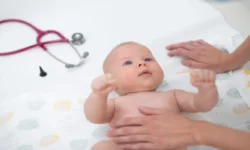What to do if your baby was injured during CTS
Having a baby is an exciting time for parents but can also be quite challenging, especially if problems arise during labor, delivery or postpartum care. Babies who suffer from colic, birth trauma, acid reflux and numerous other complications may feel great discomfort, have trouble sleeping or breastfeeding and may experience failure to thrive.
Craniosacral therapy (CST) is a special type of massage that is believed to provide relief and help alleviate symptoms from many infant health conditions. If a parent suspects that an underlying condition is causing their infant discomfort, it’s best to discuss the situation with the child’s pediatrician or to take the child to an emergency room, as needed.
Who should administer CST?
A person who is trained and skilled in CST can perform this type of massage on a baby. This includes a physical therapist, a chiropractor, an osteopath or a licensed massage therapist. To practice CST, special training and certification are required. Even if the person in question is a medical professional, if they aren’t properly trained and certified to use CST techniques, then they should not provide this type of therapy to your baby.
Is cranial osteopathy safe for babies?
A newborn baby can’t tell their parents if they’re experiencing pain or feel sick. Parents and doctors must learn to watch for signs that an infant is uncomfortable, such as high-pitched crying or trouble sleeping and eating.
To implement CST, gentle pressure is applied to a baby’s head and spine to relieve built-up pressure. Pressure is also sometimes applied in the pelvic region. This type of massage is believed to help regulate the flow of cerebrospinal fluid and remove blockages, which promotes healing.
The method of massage is thought to be both safe and effective for babies. A parent can hold an infant on their lap or have the baby lie on a table at the CST office. If a child is a bit older than a newborn, they can sit and play quietly while CST is administered.
Many parents say that their babies appeared to experience deep relaxation, sometimes to the point of falling asleep after a therapy session. Others described their babies as having a burst of energy after they have received this type of massage. It’s also possible for a baby to experience a “pins and needles” sensation, pulsing or feel intensely hot or cold.
Can a baby suffer an injury from CST?
It’s a good idea for a parent to discuss possible craniosacral therapy risks before having their child undergo treatments. Because the pressure is applied to a baby’s head, neck and spine to decompress surrounding nerves and built-up pressure, risks are believed to be minimal.
There are certain circumstances that would create ineligibility, meaning a baby with these conditions should not be given CST. For instance, a child who has had a recent head injury should not be given CST massage. Some parents say that their children seem to have experienced a mild state of discomfort following therapy sessions, which subsided in approximately 24 hours.
What can go wrong during a therapy session?
If a baby was born with a forceps delivery, is having trouble breastfeeding or seems to have frequent abdominal discomfort, their parents may decide to try CST to provide relief. CST is also said to be effective to relieve discomfort from torticollis, a condition where the head turns to one side because of muscle spasms.
When entrusting the care of an infant or young child to a craniosacral massage therapist, a parent can reasonably expect that they will adhere to protocol and act according to accepted safety standards. It’s understandable that a parent would feel worried and frustrated if their child suffers an injury during a CST session.
If a parent believes a CST specialist was negligent and that their negligence resulted in a child’s injury, they may seek justice on behalf of the child by filing a birth injury claim in a civil court. The plaintiff in such a case is tasked with providing evidence in court that not only shows that a defendant was negligent but that the negligence was a direct cause of damages.
This type of litigation is often complex and highly stressful, which is why most parents choose to act alongside experienced legal representation in court. In a successfully litigated case, the court may award compensation for damages, which can be used to help cover medical expenses or other financial distress associated with a child’s CST injury.
Think you might have a claim?
Reach out to Brown Trial Firm today for your free consultation.
- Cerebral Palsy
- Caput Succedaneum and Cephalohematoma
- Neonatal Intracranial Hemorrhage (Childbirth Brain Bleeds)
- Hydrocephalus (Extra Fluid in the Brain Cavity)
- Cervical Dystonia
- Hemiplegia (Brain or Spinal Cord Injury)
- Hemorrhagic Stroke
- Neonatal Stroke
- HIE
- Periventricular Leukomalacia (PVL) Brain Injury
- Infant Seizures
- Spastic Diplegia (Spasticity in the Legs)
- Top Risks for Birth Injuries
- Fetal Alcohol Syndrome
- Facial Paralysis
- Spinal Cord Injuries
- Bell’s Palsy
- Brachial Plexus Nerves & Erb’s Palsy
- Klumpke’s Palsy
- G-Tubes for Newborns
- Medical Errors
- Cesarean Section & Birth Injury
- Negligence in Brain Cooling Treatment
- Craniosacral Therapy
- Occupational Therapy
- Speech Therapy
- Transition From Pediatric to Adult Healthcare
- Surgical Options for Spastic Cerebral Palsy
- Fetal Intolerance to Labor
- Jaundice (Kernicterus)
- Breech Position
- Placental Complications
- Umbilical Cord Problems
- Uterine Rupture
- Cervical Incompetence (Insufficiency)
- Blighted Ovum
- Necrotizing Enterocolitis (NEC) - Intestinal Inflammation
- Cephalopelvic Disproportion
- Meconium Aspiration Syndrome
- Amniotic Fluid Embolism
- Birth Injury from Premature Delivery
- Developmental Delays
- Abnormal Cord Insertion
- Infections at Birth
- Chorioamnionitis Bacterial Infection
- Premature birth
- Oxygen Deprivation
- Listeria
- Birth-Acquired Herpes
- Placenta Previa
- Placental Abruption
- Mismanaged Fetal Malposition
- Rapid Labor
- Obesity Related Birth Injuries
- Intrauterine Growth Restriction
- Blood Clots During Pregnancy
- Ectopic Pregnancy Misdiagnosis
- Myths & Facts About Birth Injuries
- Bacterial Vaginosis
- Gestational Diabetes
- Maternal Mortality Risk
- Oligohydramnios (Low Amniotic Fluid)
- Infections During Pregnancy
- Excessive Bleeding During Pregnancy
- Congenital Syphilis


